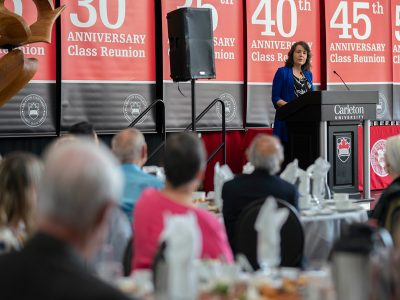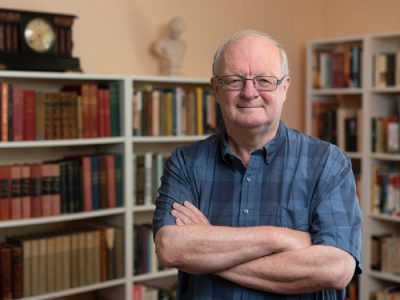By Joseph Mathieu
Photos by Luther Caverly
Maria DeRosa is looking for a needle in a haystack—actually several different needles in a variety of haystacks. Created in her lab, these haystacks are piles of DNA sequences she synthesized in the hopes that one of them would be the aptamer she had in mind.
“Aptamers are short sequences of DNA that can fold into shapes that recognize things like drugs, toxins, viruses, bacteria, pretty much any type of molecular target,” says the nanotechnologist. “And what’s interesting is that they not only bind really tightly, they’re also very specific.”
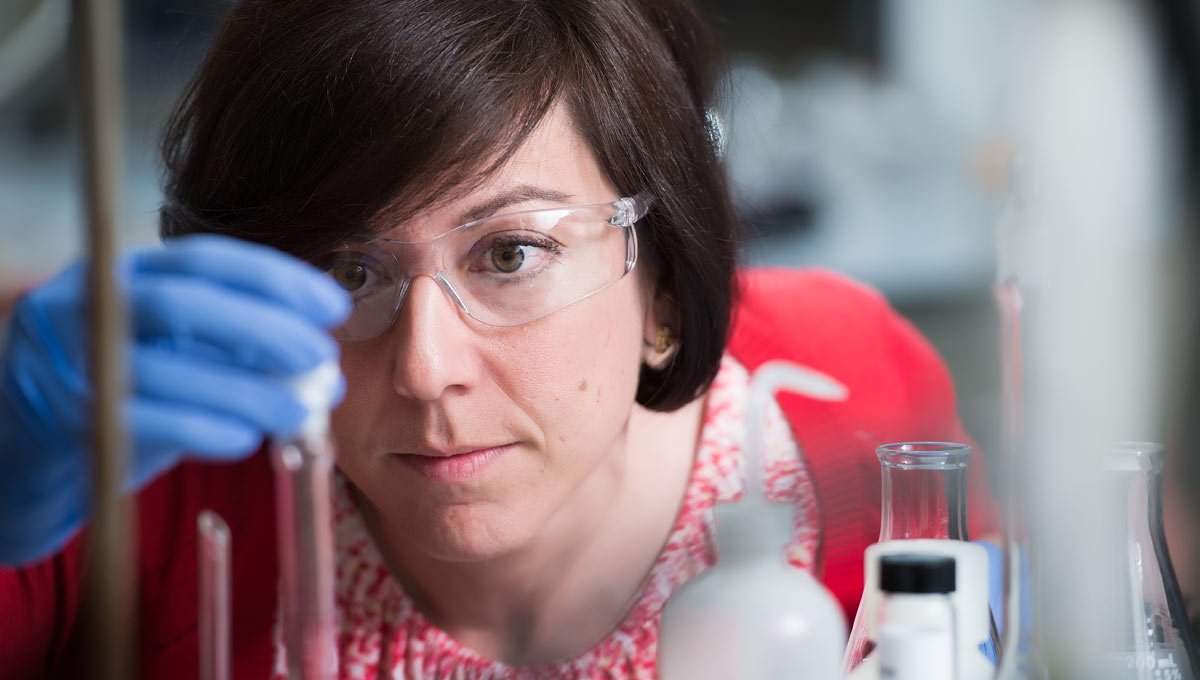
Carleton University Nanotechnologist, Maria DeRosa
A Mermade synthesizer in her lab creates the haystacks, or random DNA libraries, by combining a diverse set of reactive agents in different combinations. It takes several hours to create a DNA library, with a network of fine plastic tubes that inject different mixtures of solution into a vacuum-sealed and inert box, but it takes months, sometimes years, to find which of the aptamers does the trick.
“The sequence could be anything,” says DeRosa.
“We have limited information about the cells we want to link to, there is basically no structural data.”
Finding Aptamers Amongst Billions of Sequences
Aptamers were first synthesized in the 1990s by Larry Gold at the University of Colorado in Boulder. The Gold lab developed the selection process to find useful aptamers in the midst of billions, even quadrillions of sequences, that DeRosa uses. Called SELEX (systematic evolution of ligands by exponential enrichment), the sequences are introduced to the target molecule and cultivated to find out which one has the desired effect. Also in the ‘90s, a lab at Harvard Medical School led by Jack Szostak named the synthetic sequences aptamers, using the Latin prefix apto for “fasten” and “fit” to describe the short pieces of genetic code.
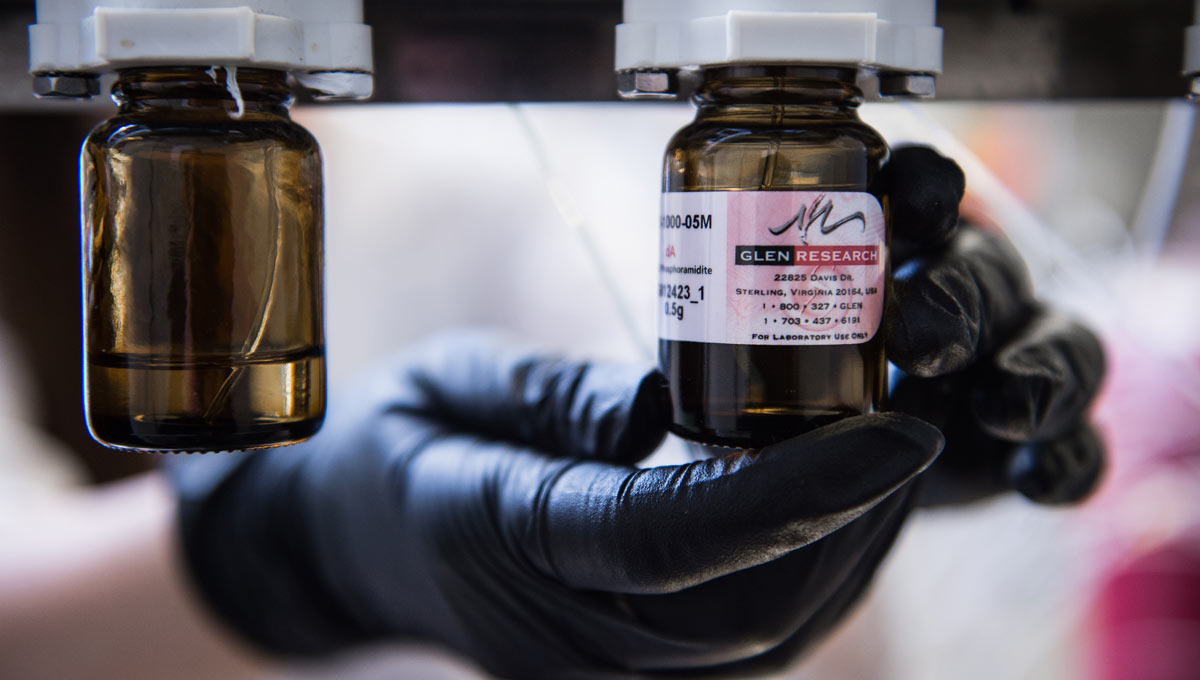
DeRosa’s aptamers can be used on a broad range of issues in agriculture, medicine and neurology. In a campus talk on April 3, she covered different case studies of the work conducted in her lab and how each aptamer solves a specific problem.
“Think of a DNA sequence like a charm bracelet,” she says. “There’s a backbone and charms that hang off it, which we call bases. We are building DNA up base by base. It’s robust, and what we want is to have cheap, portable kits that have a really good shelf life.”
“DNA, in the right conditions, has a great shelf life.”
On the third floor of the Steacie Building, her lab currently houses about 15 graduates, undergraduates and post-docs who apply their specific research to her aptamer expertise. The last library created is currently being categorized – a neurotransmitter aptamer that could help to better understand Parkinson’s disease. Another of her post-doc fellows has been using aptamers in strips similar to pregnancy tests to detect toxins in perishable foods, specifically the presence of boar taint in pork. Other tests are being developed for breast cancer and leukemia cells, and nearing the completed stages of application.
“It’s not unlike a pH paper to test the acidity of water, or the allergy tests done on your arm. Think of it more as an allergen test instead of allergy test.”
Each identified aptamer is described in how it binds to its target; where it binds, especially on complicated molecules; and the conditions in which it works best.

Lock and Key
“We can’t yet design an aptamer,” she says, “but we look at a molecule like a lock and the aptamer like a key.”
The cost of such paper tests is quite low since they can be mass produced on a tweaked ink cartridge printer. These “biomarkers” could be printed onto sheets that would react to the presence of toxins, bacteria, or even chemical weapons, by displaying a colour or fluorescence.
Having worked at Carleton as a professor in the Department of Chemistry since 2005, DeRosa’s lab came online 10 years ago. Originally from Ottawa, DeRosa completed a PhD in chemistry at Carleton. Her 2003 thesis developed chemical sensors used in airplane paints to identify where oxygen was hitting the plane. When she undertook a post-doctoral fellowship at the California Institute of Technology in 2004, she began to work with electrochemical sensors that observed DNA repairing itself in vitro.
“My post-doc also exposed me to research from around the world, and in reading papers and attending seminars, I learned more about aptamers.”
When Carleton was looking for a biology component to chemistry research in the mid-2000s, she pitched her research and its application to agricultural fertilizer. In 2010, she gave a TED talk at the Gladstone Theatre about “smart” fertilizers, which would release nanoparticles of plant food that are perfectly designed for the pores in a plant’s roots. DeRosa’s research into smart fertilizers has been supported by the Western Grains Research Foundation, a group of farmers that fund research focused on food. WGRF has also expressed interest in the DeRosa lab’s food safety application alongside industrial partners like 3M Innovation.
“Any companies that were interested in antibodies are now turning on to aptamers.”
Antibodies have been around since the 1950s, where various diseases are injected into animal hosts and the defenses of the immune system are then extracted and purified. This costly science could easily be replaced by the applied chemistry of aptamers.
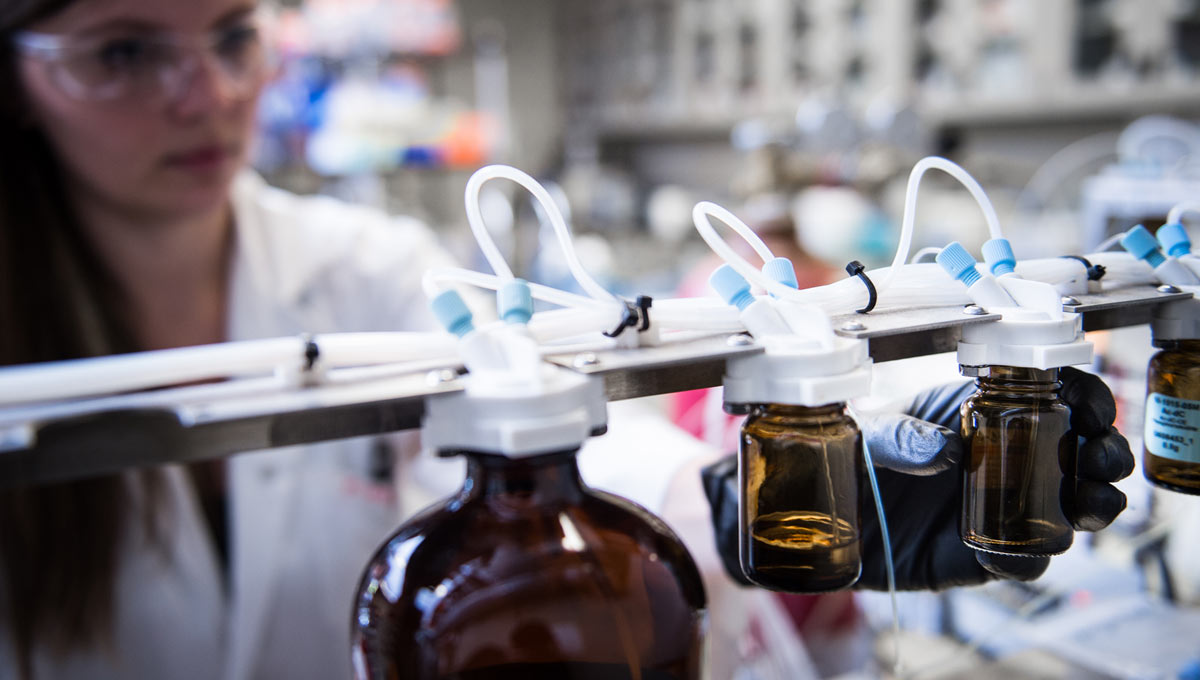
Maria DeRosa Imagines a New Agricultural Future
“What I sort of imagine with smart fertilizers is that farmers will be sprinkling these fertilizers onto their fields, but using less and getting more,” she said in her TED talk. The same philosophy of less is more applies to many aptamer applications, like the treatment of diseased cells. If a specific DNA sequence could prospectively kill targeted cancer cells without having to attack the entire immune system as many chemotherapies currently do, a more holistic cancer treatment could change the way doctors heal patients.
“It’s research worth doing,” she says. “It might sound like science fiction to most, but to understand its importance is to understand that it could have an impact on anyone in the room.
“There are probably limits to what we can do, but I’m interested in pushing those limits.”
Tuesday, April 4, 2017 in Faculty of Science, Research
Share: Twitter, Facebook
